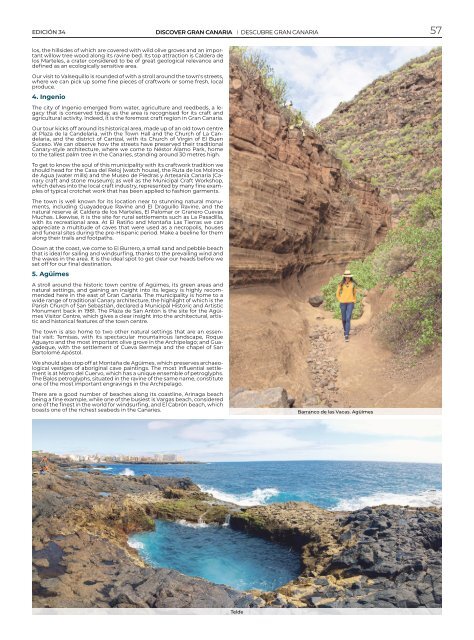No. 34 - Its Gran Canaria Magazine
Rutas, recomendaciones y noticias de Gran Canaria. Routes, tips and news about Gran Canaria.
Rutas, recomendaciones y noticias de Gran Canaria.
Routes, tips and news about Gran Canaria.
You also want an ePaper? Increase the reach of your titles
YUMPU automatically turns print PDFs into web optimized ePapers that Google loves.
EDICIÓN <strong>34</strong><br />
DISCOVER GRAN CANARIA I DESCUBRE GRAN CANARIA<br />
57<br />
los, the hillsides of which are covered with wild olive groves and an important<br />
willow tree wood along its ravine bed. <strong>Its</strong> top attraction is Caldera de<br />
los Marteles, a crater considered to be of great geological relevance and<br />
defined as an ecologically sensitive area.<br />
Our visit to Valsequillo is rounded of with a stroll around the town's streets,<br />
where we can pick up some fine pieces of craftwork or some fresh, local<br />
produce.<br />
4. Ingenio<br />
The city of Ingenio emerged from water, agriculture and reedbeds, a legacy<br />
that is conserved today, as the area is recognised for its craft and<br />
agricultural activity. Indeed, it is the foremost craft region in <strong>Gran</strong> <strong>Canaria</strong>.<br />
Our tour kicks off around its historical area, made up of an old town centre<br />
at Plaza de la Candelaria, with the Town Hall and the Church of La Candelaria,<br />
and the district of Carrizal, with its Church of Virgin of El Buen<br />
Suceso. We can observe how the streets have preserved their traditional<br />
Canary-style architecture, where we come to Néstor Álamo Park, home<br />
to the tallest palm tree in the Canaries, standing around 30 metres high.<br />
To get to know the soul of this municipality with its craftwork tradition we<br />
should head for the Casa del Reloj (watch house), the Ruta de los Molinos<br />
de Agua (water mills) and the Museo de Piedras y Artesanía <strong>Canaria</strong> (Canary<br />
craft and stone museum); as well as the Municipal Craft Workshop,<br />
which delves into the local craft industry, represented by many fine examples<br />
of typical crotchet work that has been applied to fashion garments.<br />
The town is well known for its location near to stunning natural monuments,<br />
including Guayadeque Ravine and El Draguillo Ravine, and the<br />
natural reserve at Caldera de los Marteles, El Palomar or <strong>Gran</strong>ero Cuevas<br />
Muchas. Likewise, it is the site for rural settlements such as La Pasadilla,<br />
with its recreational area. At El Ratiño and Montaña Las Tierras we can<br />
appreciate a multitude of caves that were used as a necropolis, houses<br />
and funeral sites during the pre-Hispanic period. Make a beeline for them<br />
along their trails and footpaths.<br />
Down at the coast, we come to El Burrero, a small sand and pebble beach<br />
that is ideal for sailing and windsurfing, thanks to the prevailing wind and<br />
the waves in the area. It is the ideal spot to get clear our heads before we<br />
set off for our final destination.<br />
5. Agüimes<br />
A stroll around the historic town centre of Agüimes, its green areas and<br />
natural settings, and gaining an insight into its legacy is highly recommended<br />
here in the east of <strong>Gran</strong> <strong>Canaria</strong>. The municipality is home to a<br />
wide range of traditional Canary architecture, the highlight of which is the<br />
Parish Church of San Sebastián, declared a Municipal Historic and Artistic<br />
Monument back in 1981. The Plaza de San Antón is the site for the Agüimes<br />
Visitor Centre, which gives a clear insight into the architectural, artistic<br />
and historical features of the town centre.<br />
The town is also home to two other natural settings that are an essential<br />
visit: Temisas, with its spectacular mountainous landscape, Roque<br />
Aguayro and the most important olive grove in the Archipelago; and Guayadeque,<br />
with the settlement of Cueva Bermeja and the chapel of San<br />
Bartolomé Apóstol.<br />
We should also stop off at Montaña de Agüimes, which preserves archaeological<br />
vestiges of aboriginal cave paintings. The most influential settlement<br />
is at Morro del Cuervo, which has a unique ensemble of petroglyphs.<br />
The Balos petroglyphs, situated in the ravine of the same name, constitute<br />
one of the most important engravings in the Archipelago.<br />
There are a good number of beaches along its coastline, Arinaga beach<br />
being a fine example, while one of the busiest is Vargas beach, considered<br />
one of the finest in the world for windsurfing, and El Cabrón beach, which<br />
boasts one of the richest seabeds in the Canaries.<br />
Barranco de las Vacas. Agüimes<br />
Telde















